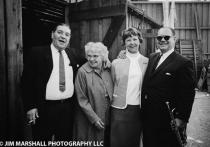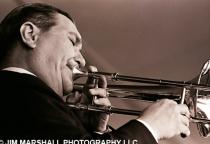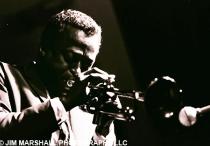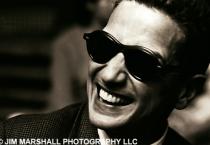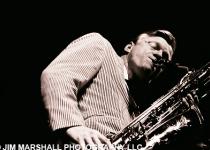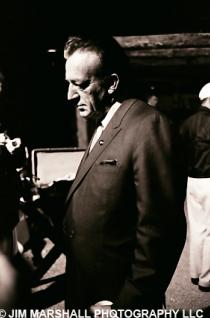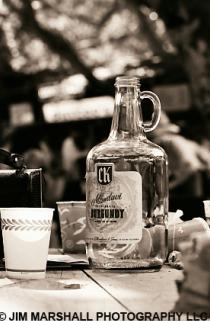Today’s blog wraps up our coverage of Jim’s early work covering jazz, specifically as the official photographer of the Monterey Jazz Festival of 1963. The more I’ve looked at and studied this early work of Jim's, the more I see how he was intent on making connections and creating a sense of intimacy, a feeling of family. I always chalked his fascination with family up to Jim’s fraught childhood, his black sheep status and how upset he remained throughout his whole life over his lack of siblings. I think that was a big reason why he was always moved so profoundly when presented with the opportunity to document moments of love and bonding that occurred among intimates, strangers and clans alike. And this lead shot of the Teagarden family is a wonderful example.
From William Minor’s Monterey Jazz Festival: 40 Years, “1963 is remembered as the year of the emotion-filled reunion of the Teagarden family. Brothers Jack on trombone, Charlie on trumpet and sister Norma on piano were joined by their mother, Helen, a ragtime pianist who jammed with her ‘children’ on stage. ‘Considering the entire history of the Monterey Jazz Festival,’ jazz educator Herb Wong says, ‘that still stands as one of the most special events.’ Most writers and fans alike found the reunion to be the Festival’s most touching moment.”
This recollection is from Jim’s lovely book “Jazz”: “I shot Jack Teagarden, his mother, Mama T, his sister, Norma, and his brother, Charlie, backstage at Monterey Jazz Festival 1963. Jack died shortly after this picture was taken in the early part of ’64, about six months later. There was a recording called ‘A Hundred Years From Today.’ It was a song that Teagarden had had a big hit with during World War II. There’s a line, ‘Don’t save your kisses, just give them away,’ and then there’s another line, ‘Who’ll ever know you gave them away a hundred years from today?’ He tells the story at the jazz festival about how, during the war, a soldier in England came up to him and requested that song.”
“I sometimes think people like Jack were just go-betweens," Bobby Hackett (a trumpeter with the Glenn Miller and Benny Goodman bands) told a friend. "The Good Lord said, 'Now you go and show 'em what it is', and he did. I think everybody familiar with Jack Teagarden knows that he was something that happens just once. It won't happen again. Not that way...”.
The Family of Jim
Jim seemed to be constantly prowling for connections to add to his "family of choice," and he knew it when he saw them. He always told me one of his biggest inspirations was the extraordinary, monumental 503-image exhibition, The Family of Man, put on at New York’s Museum of Modern Art in 1955 and curated by Edward Steichen.
Steichen described the exhibition as "a mirror of the essential oneness of mankind throughout the world. Photographs made in all parts of the world, of the gamut of life from birth to death." The essential oneness ... it's a phrase that inspires me to wrap up this series of Monterey Jazz recollections with a rather important memory from one of Jim’s treasured “family of choice,” Louisa Jane Judge aka “Janie Girl,” whom Jim considered the little sister he always wanted. It turns out Jane met Jim as a teenager at the Monterey Jazz Festival, probably 1964. Jane, who is a cultural savant, music lover and generally all-around brilliant person, had gone to check out the fest with family friend SF Chronicle music critic Ralph Gleason and his wife, Jean. “My grandfather knew Ralph quite well and suggested, since I loved music so much, that I go to the festival with the Gleasons. They took me under their wings and we sat in their box which was very close to the stage. At some point, Jim noticed me (ed note: Jane is beyond striking, a honey blonde with piercing blue eyes that can see right through a person) and asked if he could take my picture. I thought it was a little strange, but Ralph said to go ahead, Jim was OK. So we went out to the Fairgrounds where there were all these oak trees and he had me pose similarly to a shot he had just done of Judy Collins because he said we had the same eyes.
“Jim was just 24 years old or so back then and I was maybe 15, he promised to come visit me in Pasadena where I was living at the time. I remember he showed me the proofsheets of the shot of me leaning against that Monterey oak tree at the festival. I was really into photography, Edward Curtis, I loved portraiture, but I was just so young. I think I said, “Sure, they’re OK.” And then Jim started showing me all of these 8 x 10 black and whites that he had probably printed himself in his bathroom; jazz greats like Thelonius Monk that he had been taking over the past few years, a lot from his time in NYC. They were really, really strong portraits. And then he asked me, ‘What do you think, should I keep taking photographs? I looked at him like he was crazy. Why was he asking me, but then I saw he really needed to know. So I looked him in the eye and said very simply, ‘Yes, keep taking photographs.’
“And, you know, that was it. From then on we were family, I was his little sister, Janie Girl. He would always tell that story about how we met and what I said to him, how I was just a kid, but I could see it so clearly. I think it meant a lot to him because he could tell I meant it.” And then Jim's sister, who is perhaps the loveliest of all Jim’s blonde, lovely-eyed muses, remembers to add with a laugh and a sigh, “Of course, as the years rolled on I would need to change that sentence a bit to a revised, “James, put the guns away and keep taking photographs.” But, that, as they say, is a story for another day. And so concludes (for now) our look at some of Jim’s most seminal work -- his photojournalism from the Monterey Jazz Festivals of 1960 and 1963 -- where he learned to meld the personal and the professional to uncover new connections and heights in his work ... and his life.
- Jim Marshall Photography LLC Newsroom blog
- Log in to post comments
